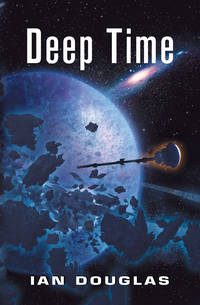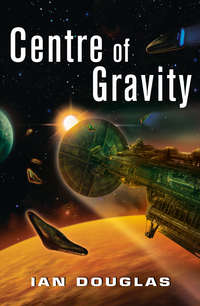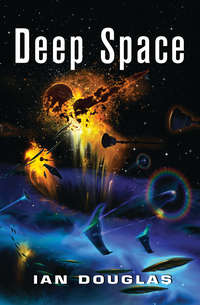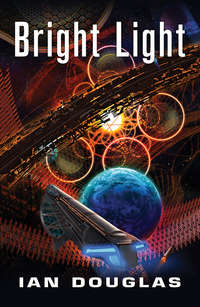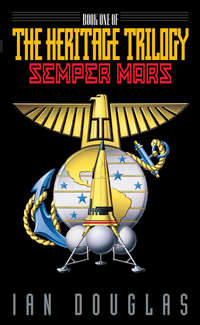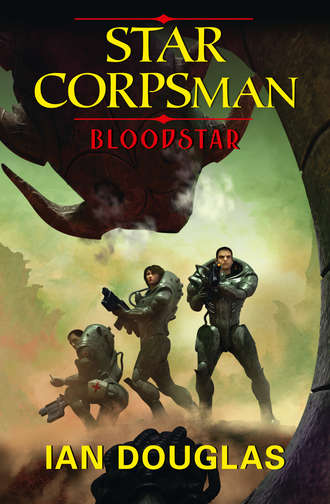
Полная версия
Bloodstar
They didn’t tell us, of course. After doing a quick check to make sure anything loose was tied down or put away—Doobie’s hooch went into a refrigerated storage tank in an equipment locker forward—we strapped ourselves standing against the acceleration couches growing out of the aft bulkhead. Ten minutes later, we felt the hab wheel spinning down, and for a few moments we were in microgravity. I could hear a Marine down the line being noisily sick—there’s always at least one—but I stayed put until the Clymer lit her main torch.
There was an odd moment of disorientation, because where “down” had been along the curving outer floor of the hab wheel, now it was toward the aft bulkhead. The bulkhead had become the deck, and instead of standing up against our acceleration couches, now we were lying in them flat. The viewall was reprogrammed to show on what had been the deck. Under Plottel Drive, we were accelerating at a steady one gravity, but “down” was now aft, not out toward the rim of the wheel.
They let us get up, then, and we spent the next hour learning to walk again. We’d been at .38 Gs for two weeks.
I was half expecting Alcubierre Drive to kick in at any time, but hour followed hour and we continued our steady acceleration. Thirty-four hours later we were ordered to the couches once more, and again there was a brief period of microgravity as the Clymer ponderously turned end for end.
That gave us an idea of where we were headed, though. There’d still been a good chance that we were headed for Europa, as originally planned. At the moment, however, Jupiter and its moons were a good six astronomical units from Mars—call it 900 million kilometers. Accelerate at one gravity halfway from Mars to Europa, and we’d have reached the turnover point in something over forty-two hours. A thirty-four-hour turnover—I ran the numbers through my Cerebral Data Feed in-head processors a second time to be sure—meant we’d covered half the current distance to Earth.
Which meant we were on our way home, to Starport One.
Once we were backing down, thirty hours out from Earth, though, we received a download over the shipnet on a planet none of us had ever heard of.
Download
Commonwealth Planetary Ephemeris
Entry: Gliese 581 IV
“Bloodstar”
Star: Gliese 581, Bloodstar, Hell’s Star
Type M3V
M = .31 Sol; R = 0.29 Sol; L = .013 Sol; T = 3480oK
Coordinates: RA 15h 19m 26s; Dec -07o 43’ 20”; D = 20.3 ly
Planet: Gliese 581 IV
Name: Gliese 581 IV, Gliese 581 g, Bloodworld, Salvation, Midgard
Type: Terrestrial/rocky; “superearth”
Mean orbital radius: 0.14601 AU; Orbital period: 36d 13h 29m 17s
Inclination: 0.0o; Rotational period: 36d 13.56h (tide-locked with primary)
Mass: 2.488 x 1028 g = 4.17 Earth; Equatorial Diameter: 28,444 km = 2.3 Earth
Mean planetary density: 5.372 g/cc = .973 Earth
Surface Gravity: 1.85 G
Surface temperature range: ~ -60oC [Nightside] to 50oC [Dayside]
Surface atmospheric pressure: ~152 x 103 kPa [1.52 Earth average]
Percentage atmospheric composition: O2 19.6, N2 75.5, Ne 1.15, Ar 0.58, CO 1.42; CO2 1.01, SO2 0.69; others<500 ppm
Age: 8.3 billion years
Biology: C, N, H, Na, S8, O, Br, H2O; mobile photolithoautotrophs in oxygenating atmosphere symbiotic with sessile chemoorganoheterotrophs and chemosynthetic lithovores in librational twilight zones.
Human Presence: The Salvation of Man colony established in 2181 in the west planetary librational zone. Salvation was founded by a Rejectionist offshoot of the Neoessene Messianist Temple as a literal purgatory for the cleansing of human sin. There has been no contact with the colony since its founding.
“Jesus Christ!” Lance Corporal Ron Kukowicz said, shaking his head as he got up out of his download couch. “Another bunch of fucking God-shouters.”
“Shit. You have something against God, Kook?” Sergeant Joy Leighton said, sneering.
“Not with God,” Kukowicz replied. “Just with God’s more fervent followers.”
“The download said they’re Rejectionists,” I pointed out. “Probably a bunch of aging neo-Luddites. No artificial lights. No AI. No nanufactories. No weapons. That’s about as harmless as you can get.”
“Don’t count on that harmless thing, Doc,” Staff Sergeant Larrold Thomason said. “If they’re living there they’ve got technology. And they know how to use it.”
“Yeah,” Private Gutierrez said. “You can tell ’cause they’re still alive!”
Thomason had a point. The planet variously called Salvation and Hell was a thoroughly nasty place, hot as blazes and with air that would poison you if you went outside without a mask.
We’d been lying inside our rack-tubes as we took the download feed—“racked out” as military slang puts it. That allowed for full immersion; the virtual reality feed that had come with the ephemeris data suggested that the numbers didn’t begin to do justice to the place. The recordings had been made by the colonizing expedition sixty-four years ago, so the only surface structures we’d seen had been some temporary habitat domes raised on a parched and rocky plateau. Bloodstar, the local sun, was a red hemisphere peeking above the horizon, swollen and red, with an apparent diameter over three times that of Sol seen from Earth. Everything was tinged with red—the sky, the clouds, and an oily-looking sea surging at the base of the plateau cliffs.
And the native life.
With the download complete, we were up and moving around the squad bay again. My legs and back were sore from yesterday, but I no longer felt like I was carrying an adult plus a large child on my back. Private Gerald Colby, at my orders, was wearing an exo-frame; they’d fused his broken tibia in sick bay an hour after his return from the Martian surface, but Dr. Francis had wanted him to go easy on the leg for a week or so to make sure the fix was good. That meant he wore the frame, a mobile exoskeleton of slender, jointed carbon-weave titaniplas rods strapped to the backs of his legs and up his spine—basically a stripped-down version of the heavier walker units we use for excursions on the surfaces of high-gravity worlds.
The rest of us had been working out in the bay’s small gym space, getting our full-gravity legs back, and taking g-shift converters, nanobots programmed to maintain bone calcium in low-G, and blood pressure in high-G. Marines on board an attack transport like the Clymer had a rigidly fixed daily routine which included a lot of exercise time on the Universals.
I shared the daily routine to a certain extent—they had me billeted with Second Platoon—but today I had the duty running sick call. It was nearly 0800, time for me to get my ass up there.
I rode the hab-ring car around the circumference to the Clymer’s med unit and checked in with Dr. Francis.
Clymer sported a ten-bed hospital and a fairly well appointed sick bay. In an emergency, we could grow new beds, of course, but the hospital only had one patient at the moment, a Navy rating from the Clymer’s engineering department with thermal burns from a blown plasma-fusion unit.
“Morning, Carlyle,” Dr. Francis said as I walked in. “You ready for Earthside liberty?”
“Sure am, sir. If we’re there long enough.”
“What do you mean?”
I shrugged. “Scuttlebutt says we’re headed out-system. And they just gave us a download on a colony world out in Libra.”
He laughed. “You know better than to believe scuttlebutt.”
“Yes, sir.” But why had they given us the feed on Bloodworld?
The doctor vanished into a back compartment, and I began seeing patients. Sick call was the time-honored practice where people on board ship lined up outside of sick bay to tell us their ills: colds and flu, sprains and strains, occasional hangovers and STDs. Once in a long while there was something interesting, but the Marines were by definition an insufferably healthy lot, and the real challenge of holding sick call was separating the rare genuine ailments from the smattering of crocs and malingerers.
My very first patient gave me pause, though. Roger Howell was a private from 3rd Platoon. His staff sergeant had sent him up. Symptoms were general listlessness, headache, mild nausea, low-grade fever of 38.2, lack of appetite, and a cough with nasal congestion.
It sounded like a cold. When I pinched the skin on his arm, the fold didn’t pop back, which suggested dehydration. “You been vomiting?” I asked. “Diarrhea?”
“No, Doc,” he replied. “But my head is really killing me.”
“You been hitting the hooch?” Those symptoms might also point to a hangover.
He managed a weak grin. “I wish!”
When I shined a light in his eyes, trying to look at his pupils, he flinched away. “What’s the matter?”
“Light hurts my head, Doc.”
I didn’t press it. Photophobia with a headache isn’t unusual. “You get migraines?”
“What’s that?”
“Really, really bad headaches. Maybe on just one side of your head, behind the eye. You might see flashes of light, and the pain can make you sick to your stomach.”
“Nah. Nothing like that. Look, I just thought you’d shoot me up with some nanomeds, y’know?”
I had a choice. I could call it a mild cold and have him force fluids to take care of the dehydration, or I could look deeper. There was a long list of more serious ailments that could cause those kinds of low-grade symptoms.
I pulled a hematocrit on him and got a 54. That’s right on the high edge of normal for males—again, consistent with mild dehydration. I took a throat swab for a culture, checked his blood pressure and heart rate—both normal—and decided on option one.
“You might be coming down with something,” I told him. I reached up on the shelf behind me and took down a bottle with eight small, white pills. “Take these for your head. Two every four hours, as needed.”
“Yeah? What are they?”
“APCs,” I told him. “Aspirin.”
“Shit. What about nanomeds?”
“Try these first. If you’re still hurting tomorrow, come to sick call again and maybe we can give you something stronger. In the meantime, I want you to drink a lot of water. Not coffee. Not soda. Water.”
“Shit, Doc! Aspirin?”
Yeah, aspirin. Corpsmen have been handing out APCs since the early twentieth century, when we didn’t even know why it worked; the stuff inhibits the body’s production of prostaglandins, among other things, which means it helps block pain transmission to the hypothalamus and switches off inflammation.
And the “something stronger” would be a concoction of acetaminophen, chlorpheniramine maleate, dextromethorphan, and phenylephrine hydrochloride—a pain reliever, an antihistamine, a cough suppressant, and a decongestant. Nanomedications can do a lot, but in the case of the old-fashioned common cold, the old-fashioned symptom-treating remedies do just as well and maybe better. We don’t automatically hand out the cold pills, though, because there are just too many creative things bored sailors and Marines can do to turn them into recreational drugs. You can’t get high on aspirin.
Howell looked disappointed, but he took the bottle and wandered out.
Next up was a Marine who was having trouble sleeping, even with VR sleep-feeds in his rack-tube.
Four hours later, I was getting ready to go to chow when a call came over the intercom. “Duty Corpsman to B Deck, eleven two. Duty Corpsman to B deck, eleven two. Emergency.”
I grabbed my kit and hightailed it. And I knew I had big trouble as soon as I walked into the berthing compartment.
It was Private Howell, screaming and in convulsions.
Chapter Three
DAMN IT! WHAT THE HELL HAD I MISSED?
Howell was on the deck in front of his rack-tube; the convulsions were hitting him in waves, and each time his muscles contracted he let loose a bellow that rang off the bulkheads. His face was bright red and sweating, his eyes wide open but apparently staring at nothing. A dozen Marines were gathered around him, trying to hold him down, trying to keep him from slamming his head against the deck. Someone had thought fast and jammed a rag into his mouth to keep him from biting through his own tongue.
I knelt beside him and felt for a pulse. Faster than two a second, and pounding.
The fastest way to derail convulsions is a shot of nano programmed to hit the brain’s limbic system and decouple the spasmodic neuronic output, a nanoneural suppression, or NNS. That’s the way we treat epileptic seizures. The trouble was, this wasn’t necessarily epilepsy, and messing with the brain, outside of relatively straightforward pain control, is not business as usual for a Corpsman.
I opened an in-head CDF channel. “Dr. Francis? I need you up here. B Deck, berthing compartment eleven two.”
“Already on my way, Carlyle. What do we have?”
“Twenty-year-old male in convulsions. Elevated heart and BP.” I hesitated. “He was at sick call this morning with symptoms of the flu.”
“Go ahead and initiate an NNS.”
“Aye, aye, sir.”
I pulled a spray injector from my kit and clicked in a plastic capsule of gray liquid, held the tip against Howell’s carotid, and fired it into his bloodstream. Elsewhere in my kit was an N-prog, a handheld device that used magnetic induction to program nanobots after they were inside the body. I switched it on and glanced at the screen.
What the hell? The device was picking up easily twice the dosage of ’bots, and they were already running a program. Not only that, they were recruiting the new ’bots, passing on their programming as the new ’bots flooded into Howell’s brain. On-screen, I could see a graphic representation of the nanotech war going on inside his brain—a haze of red dots and gray dots, with more and more of the gray switching to red as I watched.
And the seizures became more violent, horrifically so. Howell’s back arched so sharply, his hips thrust forward, I was afraid his spine was going to snap. With each thrust, he gave another bellow. The muscles were standing out on his neck like steel bars, his mouth wide open, and blood was streaming from his nose. This was not good. If I didn’t get the convulsions under control soon, he would have a massive stroke or a heart attack on the spot.
I punched in my code, then entered Program 9, holding the N-prog close to the side of his head. The remaining gray dots turned green and, slowly, slowly, the red dots began switching to green as well.
“C’mon! C’mon!” I breathed, watching the slow change in colors. Green ’bots meant they’d accepted the new program, which would guide them through the brain tissues to the limbic system and to the motor-control areas and the cerebellum, where they should start damping out the neural storm that was wracking Howell’s brain.
Damn it. I wanted to call it epilepsy, but it wasn’t, though it showed some of the same signs and symptoms. It looked as though Howell’s limbic system had just started firing off high-energy signals. The red nano was behind it, I suspected. Somehow, they appeared to be programmed to enter the limbic system and stimulate the neuron firings that had resulted in Howell’s bizarre seizure. I could see that the red ’bots were clustered in several particular spots deep within Howell’s brain—a region called the ventral tegemental area, or VTA, and another called the substantia nigra. I didn’t know what that meant; Corpsmen are given basic familiarization in brain anatomy, of course, but detailed brain chemistry is definitely a subject for specialists and expert AIs.
I needed to know what was going on in there chemically. I tapped out a new program code, setting it to affect just ten percent of the nanobots I’d just put into Howell’s brain.
Interstitial fluid—the liquid that fills the spaces between the body’s cells—is a witches’ brew of water filled with salts, amino acids and peptides, sugars, fatty acids, coenzymes, hormones, neurotransmitters, and waste products dumped by the cells. It’s not the same as blood or blood plasma; red cells, platelets, and plasma proteins can’t pass through the capillary walls, though certain kinds of white blood cells can squeeze through to fight infection. The exact composition depends on where in the body you’re measuring, but with nerve cells the interstitial fluid is where the chemical exchange takes place across a synapse, the gap between one nerve cell and another. I was telling the ’bots to begin directly sampling the mix of complex molecules floating among Howell’s neurons.
The answer came back as a long scrolling list of substances, but one formula by far outweighed all of the others: C8H11NO2. I had to look it up in my in-head reference library, and when I saw what it was I could have kicked myself.
Dopamine.
About then is when Dr. Francis arrived. “Make a hole!” one of the Marines barked, and the cluster of people around me and Howell scattered apart. I handed him my N-prog with the formula still showing on the screen.
“Shit,” was all he said when he read it.
Using my N-prog, he took over the programming of the nanobots, checking the progress of Program 9 first. There were definitely fewer of the red specks now, and a lot more of the green. In addition, some had switched over to orange, the ’bots engaged in sampling Howell’s cranial interstitial fluid.
The nanoneural suppression routine appeared to be working, once the green ’bots got a substantial upper hand over the red ’bots in numbers. Howell’s back was still arched, the muscular contractions were continuing, but they were decidedly weaker now, and expressing themselves as a long, steady quiver rather than the violent thrusting motions of a moment ago.
Dr. Francis was tapping in a new program code. “Neuroleptic intervention at the D2 receptors,” he told me. “It blocks dopamine.”
The ’bots clustered in Howell’s VTA were almost all green now, and the effect was spreading out through the motor region of his cerebral cortex and his cerebellum as well. The motor cortex is what plans and controls voluntary motor functions of the body—muscular movements, in other words. The cerebellum is the part of the brain at the very back and bottom of the organ that regulates the body’s muscular movements. It doesn’t initiate them, but it does help control them to fine-tune motor activity, timing, and coordination. Those parts of Howell’s brain had been completely out of control, causing all of his muscles to lock up in an involuntary, spasmodic seizure. As the motor-control regions relaxed, Howell’s body relaxed. His face sagged out of its rigid, openmouthed grimace, his fists unclenched, his spine eased into a more normal posture. Howell was panting now, but his eyes blinked, and he seemed to be aware of us now.
His eyes looked unusually dark.
“What happened, Private?” I asked him.
“I … dunno, Doc. I was just relaxing in my bunk, and wham! I don’t know what hit me.”
“How long have you been doing onan?” Dr. Francis asked, his voice level and matter-of-fact.
“Onan? I … ah … don’t know what you mean, sir.”
“Sure you do, son,” Francis replied. “You have enough dopamine in your system to trigger a hundred sexual orgasms. You were onanning and o-looping. Feels better than the real thing, eh?”
Of course, when the doctor said that it was all obvious. “Shit!” I said. “He’s addicted?”
“That’s one word for it,” Francis replied, studying the N-prog’s screen. “Ah. The dopamine levels are coming down. I think we’ve broken the monkey’s back.”
I only half heard him. I was in-head, opening up my personal library and downloading the entry on onan. I’d known this stuff, once, but it wasn’t the sort of thing you worked with every day, and I never thought about it.
Download, Ship’s Medical Library
“Onan,” “onanning”
From “O-nano,” a contraction for “orgasmic nano.”
Slang term referring to the use of programmed medical nano to affect the pleasure center of the brain directly in order to generate sexual orgasm. Nanobot programs can be directed to effect the release of massive amounts of dopamine in the brain, or to trigger spasmodic muscle contractions, or, more usually, both.
The term “onan” is a play on Onan, the name of a minor character in the Book of Genesis (q.v.).
Cute. I remembered it now. In the Jewish-Christian Bible, there’s the story of Onan, who dumped his semen on the floor rather than impregnate his dead brother’s wife, which apparently pissed Yahweh off so badly he struck Onan dead on the spot. For years, onanism was a synonym for masturbation, and carried with it the idea that God was going to throw a lightning bolt at you if you jacked or jilled off. What generation upon generation of relaxed but guilt-ridden teenagers afterward managed to miss was that the sin of Onan lay in his disobeying God—according to Jewish law he was supposed to father a son by his sister-in-law to preserve his brother’s bloodline. It had nothing to do with masturbation.
Today, of course, the so-called sin of Onan is long forgotten, but orgasmic nanotechnics are very much with us. You can program one-micron nanobots, you see, to go into the brain’s limbic system and trigger the neurochemical processes that result in sexual orgasm. Sometimes we do this deliberately, as a treatment for certain types of sexual dysfunction, but there’s also a thriving underground business in providing doses of sex-programmed nanobots that can go into the brain and stimulate an orgasm, and then do it again, and again, and again …
That part, programming the ’bots to give you one orgasm after another every second or two is known as o-looping, and it can be addictive—very highly so.
Not to mention dangerous.
It turns out that drugs like cocaine and amphetamines either trigger or mimic the release of dopamine, and they affect the same areas of the limbic system that light up during an orgasm—the VTA and the brain’s mesolimbic reward pathway. In fact, a brain scan taken during an orgasm shows a process ninety-five percent identical to a heroin rush. Drugs and orgasms hit the same part of the brain, and that’s what makes cocaine and other such drugs addictive.
That doesn’t mean sex is bad, of course. It’s natural, normal, and healthy. But deliberately and artificially overstimulating dopamine production can lead to an addiction requiring higher and higher dopamine levels to get the same kick as the dopamine receptors begin closing down. And the program Howell had been running, evidently, had involved overstimulation of the parts of the brain responsible for muscular contraction as well. It was a way to boost the orgasmic feeling, yeah, but it could have killed him too.
The curious thing is that dopamine doesn’t give you the feel-good kick itself. Dopamine is the hormone that makes you want—it’s the craving.
But it’s the flood of dopamine that makes a heroin addict want another hit.
And it drives our orgasmic cravings as well.
“I take it,” Dr. Francis said quietly, “that you didn’t check him for dope levels at sick call this morning.”
“No, sir.”
“Why not?”
“I didn’t see any need. It looked like a cold or maybe flu.”
“Did you look at his eyes?”
I glanced down at Howell’s face. In the harsh light from the overhead, his pupils were so widely dilated that his eyes looked unusually dark.


